| Published
on 19
Nov 2015 |
All rights reserved.
|
|
|
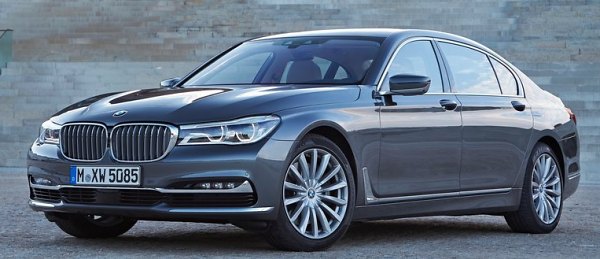 |
|
Entering
the 6th generation, can the 7-Series finally beat Mercedes S-class?
|
|
Time
passes so quickly. BMW 7-Series has entered the 6th generation with
codename G11 (or G12 for LWB version). I still remember the first
generation as it was a common sight on streets in my childhood. Today,
the 7-Series is deemed to be a top-tier luxury car. Back then, it was
more a large BMW than a luxury one. Over time, the 7er grew larger and
larger, packing more and more luxury and even flamboyant features. Its
role has changed, as does its character. Now most owners occupy
the back seat and have their cars ordered in long wheelbase form. Has
it forgotten the driver appeal that makes BMW special? I am curious to
know…
Compared with the outgoing F01/02, the new car’s exterior design is
only a small evolution. There is a certain degree of conservatism in
its design, as in the case of most rivals, but it is not as graceful as
the new Mercedes S-class or as sporty as Jaguar XJ. It has two styling
derivatives, a more civilized design (dark cars pictured) and a
sportier M-Sport trim (white car). None of them can be called beautiful
or imaginative though. Sadly, under the leadership of Adrian van
Hooydonk, BMW design is turning unremarkable.
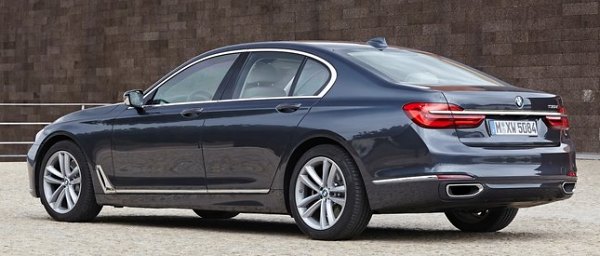 |
|
The
sleeker shape returns a Cd of merely 0.24 on base model.
|
|
Nevertheless, the new shape is very sleek, with a Cd of merely 0.24 on
base model. This is achieved thanks to active shutter grille, underbody
cladding and specially shaped door mirrors.
As the last generation was already very large, the new car gets barely
larger again. It measures 5098 mm in length (+19 mm), 1902 mm
in width (same) and 1478 mm in height (+7mm). The wheelbase is
unchanged at 3070 mm for the standard car or 3210 mm for the LWB model.
However, underneath the skin there are big changes. In order to restore
agility the G11/G12 switches to a carbon-fiber, aluminum and steel
hybrid construction, which is a world’s first for mass production. Look
at the picture of its chassis below. The black parts, including
transmission tunnel, roof rails, pillars and sills, are carbon-fiber
reinforced plastics (CFRP). They help reduce weight yet improve
structural rigidity. It goes without saying that the technology is
transferred from i3 and i8.
The silver parts, including doors, front crash structure and suspension
towers, roof, bonnet and boot lid, are aluminum, whereas the rest of
the chassis is high-strength steel. This advanced hybrid structure
helps the new 7-Series to cut kerb weight by up to 130 kg compared
with the old model. It should have been more if not offset by more
luxury equipment.
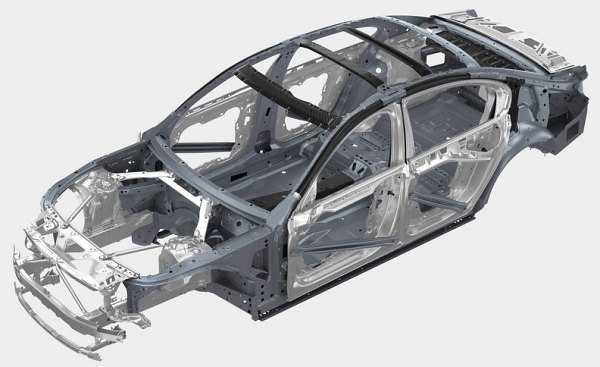
|
|
The
carbon-fiber, aluminum and steel hybrid construction is a world’s first
for mass production.
|
|
The
suspensions remain to be double-wishbone up front and 5-link setup at
the rear. Since even more suspension and brake components have been
converted to aluminum, unsprung weight is reduced by a further 10 kg.
As before, adaptive dampers are standard, while optional features
include self-levelling adaptive air springs (now also at the front
axle for the first time), active anti-roll bars and active rear-wheel
steering.
In the engine compartment, changes are quite subtle. On paper, the
4.4-liter twin-turbo V8 on 750i seems to be carried over, as its output
remains at 450 hp and 479 lbft. It has been modified in a number of
areas to improve efficiency though, such as lifting compression ratio
from 10.0:1 to 10.5:1, improving cooling system (to cut warm up time
hence cold start emission) and a partially integrated intake manifolds
(to reduce flow resistance). When mated with xDrive 4WD system, the
750i is good for 0-60 mph in an astonishing 4.2 seconds! Meanwhile, its
CO2 emission is reduced from 217 to 189
g/km.
The 8-speed ZF automatic transmission remains, but it is now linked to
GPS so that it can predict the roads ahead and make better decision.
This feature was first used on Rolls-Royce Ghost.
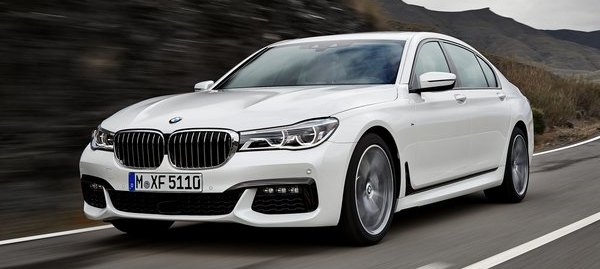 |
|
Considering
how quick the 750i is, it is really not necessary to go for the V12...
|
|
Lower down the range there are again
740i and 730d. The former employs the new modular family 3.0-liter
straight-six turbo with codename B58 (first launched in the 3-Series
facelift). Its 326 hp and 332 lbft output is hardly changed from the
last 740i, but again fuel consumption and emission are improved
considerably. The 740d is the biggest selling model in the range. Its
new 3-liter diesel adopts piezo injectors with 2500 bar injection
pressure (matching Volvo Drive-E and Volkswagen 240hp 2.0 BiTDI). This
lifts it horsepower from 258 to 265, while max torque is up from 413 to
457 lbft. Most important, it returns 63 mpg and emission of only 119
g/km, a figure more akin to family hatches a few years ago.
If that's not green enough, consider the new 740e. It is a plug-in
hybrid, with the battery stored underneath the rear seat. It pairs a
B48 2.0-liter turbo four and an electric motor (integrated into the
casing of ZF 8-speed auto) for a combined output of 326 hp. Expect 135
mpg and 49 g/km for EU combined cycle.
We don't expect an M7, but the flagship V12-powered 760Li should arrive
in a year's time. Considering how quick the 750i is, it is really not
necessary to go for the V12 unless you want to show your wealth.
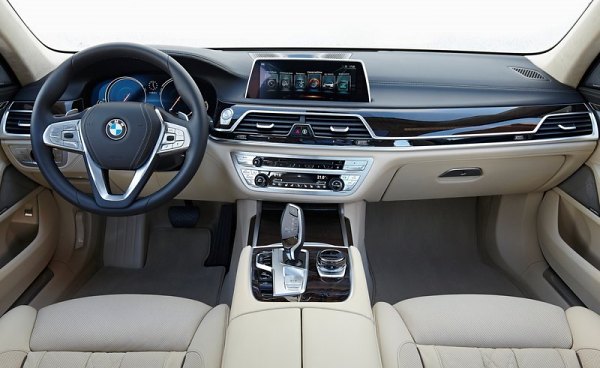
|
|
The
cabin does not disappoint for materials, build-quality and advanced
equipment.
|
|
Inside, the
BMW flagship luxury car does not disappoint for materials,
build-quality and advanced equipment. Its new TFT instrument panel
changes color across different driving modes. Its improved iDrive
control includes touch pad and an optional gesture-recognition control,
whose 3D sensors can understand the meaning of your hand gesture in
free air. The rear passengers can be served with entertainment system,
massaging and ventilating seats, reclining seats with foot rests,
lounge console, panoramic glass roof and ambient lighting with 6
different color schemes. The only minor gripe is the touch sensitive
switches on center console lack the tactile feel of mechanical ones,
but then the car compensates with a high-tech ambience.
The G11 has a number of world's firsts. Apart from the aforementioned
hybrid chassis and gesture control, it is the first production sedan to
adopt laser headlights, which offers a longer range of illumination.
Besides, it has the world's first remote control automatic parking. The
driver can get off the car and use his remote control key to instruct
the car to drive itself into the garage. Yes, most of these are only
gadgets. BMW tries hard to differentiate its flagship sedan from the
competition with a high-tech image.
 |
|
Rear
rear passengers are well served with entertainment system,
lounge console, massaging and reclining seats with foot
rests...
|
|
The most
important question is, is it as good a luxury car as Mercedes S-class?
With the additional air suspension on the front axle and all efforts
spent to improve chassis rigidity and NVH suppression, the new 7-Series
is certainly more supple and more refined than ever. However, even in
Comfort mode the suspension still lacks the ultimate smoothness of
Mercedes S-class. There is more fidgety in its low speed ride. Switch
to the new Comfort+ mode, its ride softens further, but the body
control gets poorer, displaying too much lean and vertical body motions
at reasonable speeds, again not as effective as Mercedes’ Magic Body
Control. It sounds more like a Rolls-Royce than a BMW.
No, the BMW should not be driven in this way. Dial to Sport mode and
the car comes alive. Its body control is clearly beyond the level of
Mercedes, thanks in part to the electro-hydraulic active anti-roll
bars. It feels taut and controlled. Turn-in is relatively quick with
the help of 4WS. The balance is good for a large car. The grip is
strong. Unfortunately, all these merits are ruined by a numb steering.
The new car has ditched the variable-ratio steering of the old car for
a fixed ratio rack (still electrically
assisted). Its weighting gets lighter,
but the real problem is lack of feel. In my memory none of the last 5
generations had a steering as numb. I suspect the addition of air
springs to the front suspensions is the root cause, as it has all the
road information effectively filtered.
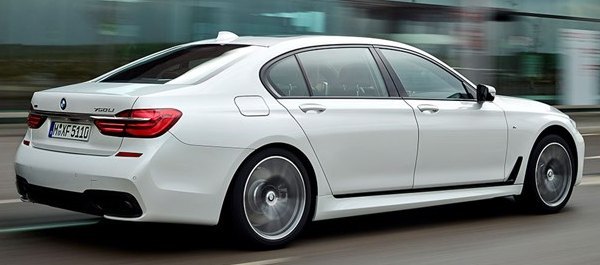 |
|
The
fine chassis is ruined by a numb steering, which means the 7er could no
longer attract a keen driver to the helm...
|
|
Yes, Mercedes has a similar problem, but the fact that a BMW
steers like a big Mercedes is not so amusing. Losing the steering feel
means the 7-Series could no longer attract a keen (but wealthy) driver
to the helm. They are more likely to lean at the back seat like the
owners of most other limousines. Is this still a true BMW? I am puzzled.
BMW’s engines still shines. Even the base 3-liter diesel is smooth and
responsive, while the petrol V8 is as great as ever. Performance and
drivetrain refinement are beyond criticism. But that alone could not
engage the driver.
The 7-Series has evolved to a stage that it has to decide which way to
go: the luxury path like the mainstream, or the driver’s car path like
its ancestors? It tries to bridge both worlds, but the result is
compromised. On the one hand it is not quite as comfortable as
Mercedes, on the other hand it is not engaging enough to attract keener
drivers. Is this the inevitable fate of modern luxury limousines? Let’s
hope the next generation Jaguar XJ will do better.
|
Verdict:     |
Published
on 11
Feb 2017
|
All rights reserved.
|
|
M760Li
|
|
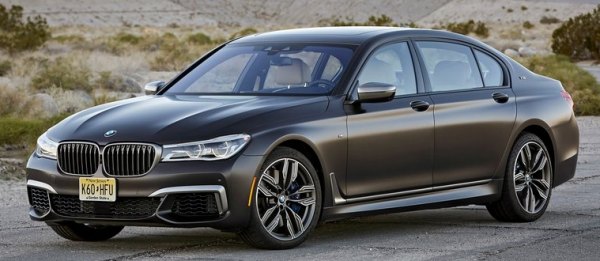
|
|
Can
the M-badge save BMW's V12 limousine from extinction?
|
|
I remember in 1987, the
launch of BMW 750i caused quite a sensation. Back then, the only other
luxury car featuring V12 power was the aging Jaguar XJ12. Mercedes had
yet to build its first 12-cylinder engine (not until 1991), let alone
Audi, whose maximum cylinder count was only 5 (in fact, it was yet to
be transformed into a luxury brand). All the other 12-cylinder engines
served Italian exotics. BMW’s 5-liter, 300hp V12 opened a new era,
promoting the 7-Series to a status somewhat superior to the
contemporary Mercedes S-class.
30 years later, BMW is still building V12 engine for the 7-Series, but
the atmosphere is very different. Regulatory and environmental
pressures force many manufacturers to either stop or slow down their
development of 12-cylinder engines. Munich is no exception. On paper,
the 6.6-liter twin-turbo direct-injection V12 on M760Li looks exciting
– its 610-horsepower output enables the heavyweight limousine to
achieve 0-60 mph in an amazing 3.6 seconds, eclipsing even the outgoing
M5 Competition pack to be the fastest series production car in BMW’s
history. However, have a closer inspection of the engine hiding under
the black plastic cover, you will find few improvements over the last
version. Yes, its capacity has been increased by 10 percent, but this
change was already reflected on Rolls-Royce Ghost some 7 years ago. The
valve timing of Bi-Vanos has been tweaked, and the direct injection
pressure is up, but BMW declined to add its Valvetronic system to the
V12, which could have reduced its emission and fuel consumption.
Likewise, it refused to introduce cylinder deactivation, which is a
pity since cylinder deactivation would be a perfect match with V12 –
something even a small player like Aston Martin understands (see DB11).
Apparently, Munich has largely stopped the development of its V12 in
the view of its pessimistic future.
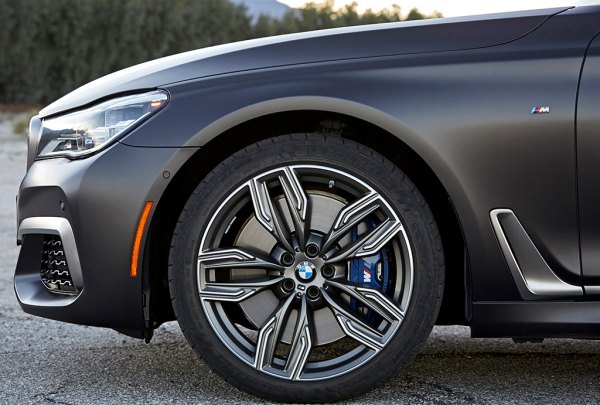
|
|
The
V12 still lacks cylinder deactivation, something even Aston Martin has
adopted. Seems that BMW has largely stopped the development of its
V12...
|
|
While 610 horsepower looks a lot, it represents a specific output of
less than 100 hp per liter, which is hardly world-class these days.
Mind you, the version on Rolls-Royce Wraith is more powerful at 632 hp.
Both engines’ maximum torque are capped at 590 lbft to avoid
overloading the ZF 8-speed automatic. The V12 of Mercedes-AMG S65 is
much torquier at 738 lbft. Most telling, AMG’s latest E63 S needs only
8 cylinders and 4 liters of displacement to eclipse the 6.6-liter V12
in both power and torque, yet its hot-V turbo arrangement demonstrates
keener throttle response. The BMW V12 is really showing its age.
Moreover, these 610 ponies have to haul some 2180 kilograms plus
occupants and luggage. There is no denial that 0-60 mph in 3.6 seconds
is really quick, but part of the improvement comes from the standard
xDrive 4WD system and faster transmission calibration. This means the
car feels fast but not sensational enough to compare with smaller
sports sedans. To extract its performance, you need to keep planting
the throttle harder than expected, blame to that weight. By upgrading
to V12 power, the checkboxes of long-wheelbase body, xDrive, 4WS, air
suspension and active anti-roll bars are checked automatically. These
put an additional 370 kg over a standard 750i and have the 160hp / 110
lbft advantage largely cancelled. In normal driving, the 750i doesn’t
feel much slower than the M760Li.
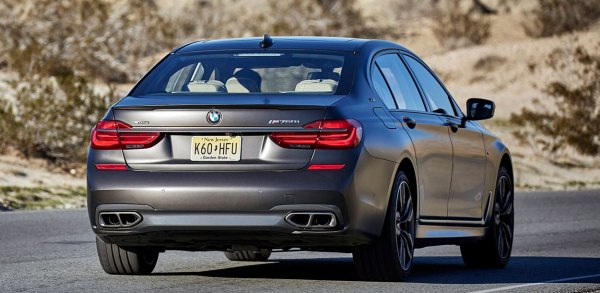 |
|
To
extract its performance, you need to keep planting the throttle harder
than expected, blame to that 2180kg.
|
|
However, it would be wrong to describe the M760Li as completely
superfluous. Even though it is not an M7 – there won’t be such a car,
probably forever – it is an “M Performance” car like M235i, so it is
given a sportier character than the regular 7-Series models. The chief
difference does not lie on hardware but the way the driver selectable
control system is programmed. Comfort mode remains calm and relaxing,
but Sport mode is tuned up to show a marked difference, no matter
throttle response, gearshift speed and body control. The steering rack
is set a little bit quicker, although it remains very numb at the
straight ahead position. The rear-wheel active steering makes the big
car feel more like a 5-Series in tighter roads. For a car so large and
heavy, it controls its body motions pretty well, but we would call it
progressive and predictable rather than sharp or agile. The 4WD affords
remarkable grip, but it also turns the car into early understeer more
easily than proper sports sedans, despite the presence of 4WS. If you
keep pushing it, you will eventually overcome the understeer, but that
calls for a lot of road space and, obviously, no one would take the
M760Li to track days.
While the M760Li is slightly sportier than 750i, it is well beaten by
Porsche Panamera in all dynamic measures. After all, it is
essentially a luxury limousine fitted with a bigger engine, rather than
a sports sedan added with luxury touches. Meanwhile, a Mercedes-AMG S63
still does the luxury job better than BMW, offering better ride and
refinement as well as a more graceful appearance. The BMW V12 sounds
more subdued than the AMG V8, too, which is
a shame. Adding the M badge does not make the life of 760Li any easier.
|
Verdict:    |
Published
on 10
May 2019
|
All rights reserved.
|
|
7-Series facelift 2019
|
|
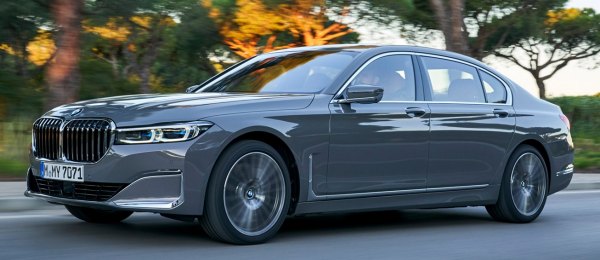
|
|
Function
loses, but Form doesn't win either.
|
|
Is that double-kidney
grille too big? Like the recent X7, the facelifted BMW 7-Series gets a
huge grille, which is 40% larger in area and raising the leading edge
of the bonnet by as much as 5 cm. It is supposed to give the car a more
graceful look, although I don't think it suits the 7-Series, which is
traditionally one of the most athletic cars in the F-segment. The
grille is so large that BMW actually needs to seal its upper part, and
uses automatic shutters to reduce air coming into the engine
compartment. Function loses, but Form doesn't win either.
Apart from the bigger grille, the 7-Series gets also slimmer headlights
and taillights, while the front bumper is redesigned, incorporating
deflector plates to guide air flow towards the brakes and side air
curtain more efficiently. At the side, the chromed air outlet located
just behind the front wheel is redesigned to be more upright, just like
the grille.
Far fewer changes are applied to the interior. The dashboard, console
and infotainment system are left unchanged. The TFT instrument remains,
but the graphics are updated, employing a more stylish reading like the
recent 8-Series. Unfortunately, in the name of style, the rev counter
has been set aside and configured to work anti-clockwise. In other
words, difficult to read. Function loses, although Form might win.
No changes can be found on the chassis, but as usual, the mid-life
facelift brings some updated engines. The most important one is 750i,
whose 4.4-liter twin-turbo V8 has been updated to the version of
8-Series. This means its power output is lifted significantly from 450
to 530hp, while peak torque increased from 479 to 553 lbft. Now the
750i is really quick, taking only 3.9 seconds to go from rest to 60mph.
Part of this improvement is contributed by the xDrive system.
Rear-drive is no longer available to the 750i.
In contrast, the range-topping M760Li gets a slight detuned, probably
due to fitting particulate filter. Output is reduced by 25hp to 585hp.
Although maximum torque is improved from 590 to 627 lbft, it cannot
stop the flagship model, which is likely to be heavier than before, to
run slower. 0-60mph is extended by a tenth to 3.7 seconds. The lesser
750i is so close that it might be a better bet, especially when it is
lighter thus should be better to handle.

|
|
The
750i is very fast, fast enough to threaten an M3 on a straight.
|
|
The six-cylinder petrol 740i gains 14 hp but no more torque. Taking its
limelight is the plug-in hybrid 745e. That model abandons the old car’s
4-cylinder engine for a detuned version of the 3-liter turbo six, rated
at 286hp, and an ZF hybrid transmission incorporating a 113hp electric
motor. Combined output is 394hp and 442 lbft. 0-60 takes 4.9 sec, while
EV range is up to 36 miles, limited by the 12kWh battery.
A trio of 3-liter straight-6 diesel engines continues to serve the
7-Series without change. 730d uses a single turbo to produce 265hp /
457 lbft, 740d employs 2 sequential VTG turbos to generate 320hp and
501 lbft, while 750d uses a mighty quad-turbo system (2 large and 2
small, arranged to work in multi-stage) to punch out 400hp and 560lbft.
They achieve 0-60 in 5.8, 5.0 and 4.4 seconds, respectively. No
7-Series models could be described as slow.
In the real world, this engine range is virtually unbeatable. The 750i
is very fast, fast enough to threaten an M3 on a straight. It is
ridiculous for a full-size luxury limousine. Meanwhile, the 745e is
still quick enough, but its strength is smoothness, so smooth that its
hybrid powertrain might be best suited to the purpose of the car. Not
that the V8 is less refined. In fact, with improved insulation, it is
remarkably quiet when crusing on highway.
In general, the BMW flagship sedan feels a little bit sportier than the
rivalling S-class and A8. It steering is heavier and its suspension is
a tad firmer in sport mode. However, on narrower, twistier roads, it
still feels too big and heavy. I remember the first generation 7-Series
was a common sight on street when I was a schoolboy. It was adequately
sized. Today, a 5-Series is larger than that car, and the 7-Series is
an alternative to Rolls-Royce. The new 750i gains nearly 100kg in the
facelift, pushing its kerb weight to just under 2 tons. Even with the
help of 4-wheel steering and active anti-roll bars, it won't match a
smaller car on a narrower road. This means, keen drivers are unlikely
to opt for the 7-Series. Its buyers are more likely to occupy the
second row, which is vast and comfortable enough to match an S-class.
Nevertheless, the Mercedes offers a slightly smoother high-speed ride,
so it is still the first choice for luxury. Moreover, it doesn't sports
a grille so large and ugly.
|
Verdict:     |
|